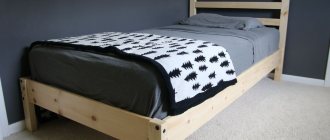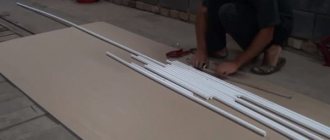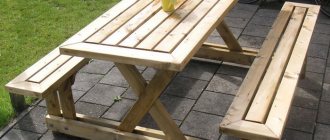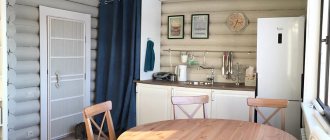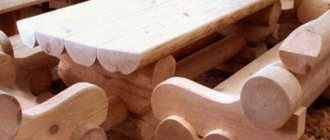A bathhouse is the best remedy for bad mood and colds. It saves both from the blues and from dirt, gives a feeling of vivacity of spirit and body, brings people together, and becomes a serious hobby. One problem is the lack of space for its construction.
Do you dream of becoming the proud owner of a “bath establishment”, but the area of the plot does not allow you to realize all your fantasies? Stop sighing! A true fan of cleanliness and a connoisseur of light steam will not give up so easily! There is a barrel sauna especially for such people.
What kind of miracle device is this? Despite its non-standard appearance and small dimensions, in all respects it is a full-fledged alternative to the classic version. Of course, there are pros and cons to the barrel
. Let's take a closer look at them.
Advantages of a barrel sauna
Are you “confused” by the compact size of the structure and its non-standard appearance? So these are advantages! You can install a neat, beautiful bathhouse on a few square meters, and its original design will attract not only family members. Of course, dimensions and design are not a complete list of advantages.
A barrel sauna is:
— a spacious steam room (it can easily accommodate an average family or a small group of 4 adults);
— significant savings in money (its cost is much lower than the cost of constructing a standard building);
— good thermal insulation, thanks to which the rooms will remain warm and cozy for a long time after heating;
— greater ease of use (heats up quickly, does not require any special care);
— mobile design, which, if necessary, can be easily moved from place to place;
— original design that promotes relaxation and better recovery;
— possibility of operation immediately after purchase and connecting communications to it;
— quick cleaning due to the design features;
- environmental friendliness;
— aesthetics;
- safety;
— no need to register the building;
A significant advantage of a barrel sauna is that it is not at all difficult to improve the area around it. The compact design will organically fit into the surrounding design, becoming an effective decoration and functional design element of the site.
Despite the obvious advantages, the barrel bath also has disadvantages. Although, if you look closely, what are these disadvantages?
Advantages and disadvantages
Each structure has its own pros and cons, so you need to know what to choose.
Among the advantages it is worth noting:
Compactness. There is no need to wonder whether your barrel sauna will fit on small acres in your country house or garden plot, the answer is clear - it will fit.
Barrels are produced by manufacturers in various sizes and it will not be difficult to choose exactly your option, taking into account factors such as design, shape and even the material from which your home sauna will be made.
Speed of kindling. Due to the fact that the structure is relatively small in size, the kindling time is reduced to a minimum.
This is a definite plus, because you don’t need to stand at the stove for hours, preparing for the arrival of friends who want to relax in your steam room, or when you come home from work, you can prepare yourself a home healer in a matter of minutes.
However, it is worth considering that when used in winter, it is worth using additional insulation around the perimeter of the building in order to reduce the frequency and frequency of heating the stove.
Mobility. Perhaps one of the most significant advantages of using it is that you don’t need to calculate the dimensions of the foundation, occupy part of the territory on a permanent basis, but can easily be placed anywhere, knowing that the barrel sauna will fit perfectly into the interior and can be moved at any time, without fear of landscape or site design.
Economical. Absolute savings in kindling materials. Just a few logs will create pleasant warmth, and thanks to the compact size of the room, it will quickly spread throughout the entire area and the barrel sauna will welcome you into its warm embrace.
The presence of such a component as insulation around the perimeter will additionally help in creating efficiency.
The disadvantages include:
Lack of space. Probably, for many this is the main disadvantage, because... You can’t fit a dozen or two friends into a small room.
However, for family use with several people staying there at the same time, it will be very acceptable.
Coordinate a schedule for visiting your home complex with friends and then the minus will turn into a plus, and the barrel bathhouse into a real irreplaceable assistant.
Cooling down. Small area and cools down faster. You don’t need to be a physicist to understand this minus, because... After a couple of hours of going in and out of the steam room, the heat begins to subside.
But if you use insulation and heat it as needed, then this fact will not become a problem.
It is also worth paying attention that the insulation must be made of high-quality, natural materials. An additional property that insulation must have is non-flammability.
Does a barrel sauna have any disadvantages?
There are no limits to perfection, so even the most technically competent solution may not suit someone. Let’s figure out what claims are “made” to the barrel bath.
- Small steam room. This is a serious remark that, due to the compact size of the building, cannot be corrected. And why? If a sprint race or GTO test is planned indoors, then size matters. And in a neat steam room that heats up perfectly, a friendly company of 4 adults will have a very good time. If 5-10 people are steaming on the shelves at the same time, then you will have to forget about the quality of steam, the atmosphere of comfort and relaxation.
- Lack of insulation. Most models have a “lightweight” design, which does not require the presence of substantial insulation. If the barrel sauna is used in an area that is not characterized by severe frosts, then this “disadvantage” will not affect its performance characteristics. In harsher climates, additional insulation will be required.
- The steam room cools down quickly if the door is often opened outwards. However, the room in a stationary bathhouse cools down just as quickly, especially if more than 4 people are steaming in it.
Preparation of materials
The most complex design element here will be the stove - you will most likely have to buy it ready-made. You will also need to purchase six items.
Boards and beams
For the bath you will need the following timber:
- Beam with a cross section of at least 10 x 10 cm for stands.
- An edged board with a thickness of 45 - 50 mm and a width of 10 cm is used for assembling end and side walls. The boards must be pre-treated to prevent rotting.
- Wooden door with frame.
- Lumber for the manufacture of shelves and lattice trays.
When choosing boards, be sure to pay attention not only to their parameters, but also to the connection: it should be carried out using the tongue-and-groove technology.
Screed
Rigidity of the building is given by tightening metal hoops made of steel tape with corrosion protection. The same principle works here as in ordinary wooden barrels and tubs. To ensure better grip of the hoops, iron clamps are used. When the wood dries over time, these clamps can be used to adjust the screed to avoid the formation of cracks.
Doors and windows
It is best to entrust this matter to professionals who will produce glass doors and windows that fit perfectly into the openings. The openings themselves are cut out in the front and rear end walls of the bathhouse. First, markings are made, then they are cut out and, if necessary, reinforced with bars.
Interior lining and furnishings
Barrel-shaped baths are constructed from natural wood, so they are often left without interior lining. But the space from the inside requires some work—this applies to the flooring. It is made in the form of a lattice. It is also necessary to make flooring because it is not very convenient to move along the rounded base.
Benches in a round bathhouse are usually made of linden.
Roof
At the end of the work, the roof is installed. Typically, flexible tiles and sheets of metal are used as a roof. A gable roof is also being built. In this case, the slopes are made of metal tiles or corrugated sheets.
Build or buy a bathhouse?
Owners of suburban areas and houses within the city face a difficult choice. What to do? Should I build a stationary large sauna or buy a ready-made one? There is no clear answer to this question. Everyone must decide for themselves and set their priorities correctly.
If you want to spend precious time on the worries and hassles that are inevitable during construction, then in a few years a bathhouse will appear on the site. In this case, there is no need to talk about saving money.
If you don’t want to wait, plus the square meters on the site are not at all superfluous, then a barrel sauna is the best option.
Select a bathhouse in the catalog
Bathhouse projects
Number of projects 683
- 1 room
- 1 bathroom
Bathhouse project "Pechkin"
- To favorites
- 27.5² Total area
- 5 x 7m Construction area
from RUB 751,700
Construction time individually
- 2 rooms
- 2 bathrooms
Bath Antoine project
- To favorites
- 115² Total area
- 11 x 7m Construction area
from 1,552,500 rub.
Construction time 62 days
- 1 room
- 1 bathroom
Brigita Bath Project
- To favorites
- 32.5² Total area
- 7 x 5m Building area
from 438,750 rub.
Construction period 45 days
- 1 room
- 1 bathroom
Project of a garden house-bath "Siano"
- To favorites
- 19.4² Total area
- 4 x 6m Building area
from RUR 261,899
Construction time 2 days
- 1 room
- 1 bathroom
Bani Afonya project
- To favorites
- 43² Total area
- 9 x 7m Construction area
from 580,500 rub.
Construction period 35 days
“Super-Lux” octaval bath project
- To favorites
- 2 x 5m Building area
from 214,900 rub.
Construction time 1 day
- 1 room
Project of log bathhouse 3x5 m
- To favorites
- 15² Total area
- 3 x 5m Building area
from 130,000 rub.
Construction time individually
- 1 room
- 2 bathrooms
Bathhouse project FBN-1-1-231 / Swimming pool
- To favorites
- 230.91² Total area
- 17 x 19m Construction area
individual calculation
Construction period individually
Project of log bathhouse 6x4m
- To favorites
- 6 x 4m Construction area
from 390,000 rub.
Construction time individually
- 1 room
- 1 bathroom
Bathhouse Matryoshka project
- To favorites
- 55² Total area
- 8 x 9m Construction area
from 742,500 rub.
Construction period 35 days
- 1 bathroom
Bath Mario project
- To favorites
- 58.43² Total area
- 9 x 8m Construction area
from RUR 788,805
Construction period 36 days
- 1 bathroom
Super-luxe barrel sauna project
- To favorites
- 11.4² Total area
- 6 x 2m Building area
from 168,000 rub.
Construction time individually
- 1 room
- 1 bathroom
Bani Colonel Project
- To favorites
- 55² Total area
- 9 x 9m Construction area
from 742,500 rub.
Construction period 35 days
Project of a log bathhouse 6x4m with a sloping roof
- To favorites
- 45² Total area
- 6 x 4m Construction area
from 265,000 rub.
Construction time individually
“Lux” octaval sauna project
- To favorites
- 2 x 4m Building area
from 204,900 rub.
Construction time 1 day
- 1 room
- 2 bathrooms
Project Baths 10B-K
- To favorites
- 27.4² Total area
- 5 x 6m Construction area
from RUR 219,143
Construction period 18 days
- 2 rooms
- 1 bathroom
Hobart Baths Project
- To favorites
- 72² Total area
- 8 x 9m Construction area
from 1,006,000 rub.
Construction time individually
- 1 room
- 1 bathroom
Bath Pergola Project
- To favorites
- 63² Total area
- 7 x 9m Construction area
from 850,500 rub.
Construction period 30 days
- 2 rooms
- 1 bathroom
Bath Comfort Project
- To favorites
- 6 x 6m Construction area
from 268,700 rub.
Construction time individually
Mega Mobile Bath Project
- To favorites
- 12² Total area
- 2 x 5m Building area
from 226,900 rub.
Construction time 5 days
View all projects
The original cylindrical structure for bathing procedures in the local area not only has attractive features for the design of the local area, but also has a number of practical properties, allowing you to save space, materials and construction costs. Let's look at what a do-it-yourself barrel sauna made from boards is like - how to make a base, walls, lining, drain and install a stove, what materials will be required for this and what technological features will need to be taken into account.
DIY barrel baths Source we build with our own hands.rf
Do-it-yourself technology and stages of construction
The main feature of a barrel sauna is its barrel-shaped or cylindrical shape. Two round end panels with a diameter of 2.5-3 meters are sheathed with boards, forming a cylindrical body. The boards are tied together with bandage tape. Minimal contact with the ground provides good thermal insulation. Inside the barrel, a floor is laid, benches, a sauna stove, and, if necessary, partitions are installed.
The light summer cottage option is limited to this; 1-2 people can steam in a 2-meter barrel with minimal amenities. More advanced structures up to 12 meters long are connected to electricity, water supply and drainage, have a steam room, soap bar, shower, forced ventilation and a relaxation area. They can accommodate up to 5-6 people.
The doors in the partitions are made of wood; in expensive models, they are made of tinted or frosted glass. Sometimes, instead of a small window in the end panel, it is made entirely or completely from tempered glass or double glazing.
Barrel baths also include miniature single-seat baths made from a half-barrel standing vertically. Ofuro, or Japanese heated bath, is gaining popularity outside of its native country.
Despite the apparent simplicity of the design, building a sauna-barrel with your own hands will require certain skills from the owner. Among them:
- working with drawings;
- engineering and construction calculations;
- excavation work to prepare the site;
- carpentry and joinery work for assembling and arranging a bathhouse;
- installation work for installing a stove and chimney, connecting to communications.
In addition, you need time. Assembling a bathhouse from a prepared kit by an experienced team can assemble a bathhouse from a prepared kit in a day, but you will have to tinker with it yourself, including with the selection and preparation of materials.
The vast majority of bathhouses assembled by hand are made of wood. when choosing a material, they usually stop at hardwoods, such as oak, beech, larch, cedar or linden. The use of coniferous wood is not recommended, since they release resin abundantly when heated. They can only be used for load-bearing structures and external cladding, provided that sufficient thermal insulation is installed.
To connect structural elements, metal parts are used, such as self-tapping screws, corners, and bandage tapes for tightening the bath-barrel. Care must be taken to ensure that they do not protrude above the surface of the wood. Touching it may cause serious burns. The upper part of the cylinder-barrel is covered with a soft roof or metal profile to protect it from precipitation.
The stove-heater in such a bathhouse is installed in metal, with a built-in tank for heating water. For the most compact barrel options, where every square centimeter counts, choose the option with a tank located on the chimney.
All electrical equipment must be adapted for operation in wet rooms; it is mandatory to install charge disconnecting devices (RCDs) to protect against electric shock.
To assemble the bath you will need:
- tongue and groove boards 25-30 mm thick, 80-90 mm wide;
- timber 100*100 for the installation of supporting structures;
- boards up to 2 meters long for arranging bath furniture”;
- doors and windows;
- fittings and fasteners;
- metal tape with bandage fastenings;
- roofing materials;
- plumbing equipment: drains, taps, pipes, fittings; sinks, etc.;
- wires and electrical installation elements: lamps, switches, etc.
To make a barrel bath you will need tongue and groove boards.
During assembly you will need the following tools and accessories
- cordless or corded screwdriver;
- a circular saw;
- jigsaw;
- hand carpentry tools: chisel, axe, mallet, hacksaw, etc.;
- measuring instrument: tape measure, corner, level;
- tools for excavation work: shovel, wheelbarrow, buckets.
- painting tool.
A grated flooring is usually installed on the floor; it makes it easier to walk on the concave floor and provides ventilation for its boards.
The bathhouse is installed with a slight slope to ensure water drainage. At the end of the slope, a drain grate is installed; a drainage pipe is connected to it from the outside, leading to a separate sewer well or to a general sewer. Minimum-sized baths without running water may not be connected to the sewer; a small amount of waste water can be dispersed in the crushed stone-sand floor of the site. But in this case, in the bathhouse you can only steam and splash yourself with water; soap and shampoos can damage the plantings.
We invite you to familiarize yourself with the chimney for a bath through the wall
Particular care must be taken to monitor the quality of thermal insulation near the stove and chimney; violation of the rules can lead to a fire.
Before you start selecting and purchasing material for building a bathhouse - do-it-yourself barrels, you will need drawings of the object in three projections. You can also build a 3D parametric model of it using one of the free home building design programs available online. Such programs also contain a module for calculating the amount of material required and save a lot of time.
Drawing of a barrel sauna
For those who decide to do things the old fashioned way and draw and count by hand, experienced craftsmen offer a number of recommendations:
- Choosing the length of the building. The timber is supplied in a standard length of 6 metres, so the most efficient use of the material will be obtained with a length of 2 or 3 metres, so that the board is sawn into 2 or 3 parts. Intermediate values will result in large amounts of residue. The remains from the boards will go to the end walls. Treated boards are also supplied in lengths of 3 and 2.2 and 2 meters, this must be taken into account when designing interior decoration and furniture.
- Choice of diameter. The average height is about 175 cm, the height of a standard bath door is 170 cm, so the minimum diameter is 2 meters. As the diameter increases, both comfort and costs for materials and heating increase. Barrel baths with a diameter of more than 2.5 m are rarely found.
- Space planning. All doors must open outward. If someone becomes unconscious due to heat or humidity, their body should not block the door and prevent them from coming to help. Doors in internal partitions are placed centrally so that the roundness of the ceiling does not prevent them from opening completely.
- The stove is usually installed at the end, so that you don’t have to walk past it. If the stove is placed near an internal partition for the firebox outside, a protective wooden grille-fence should be provided.
The number of boards for cladding is calculated based on the circumference
where D is the diameter of the barrel. The length of the circumference must be divided by the width of the board and get their number.
Experienced craftsmen described how to build a barrel sauna with your own hands. Construction is divided into the following stages:
- Site arrangement. The barrel can be installed on any flat surface - asphalt, concrete slab, paving slabs. You can also arrange a sand and gravel cushion. You should choose a pit with a depth of 0.2 m, a length equal to the length of the barrel and a width equal to the diameter plus 0.5 m. The depression is filled with 10 cm of sand and compacted, with large crushed stone on top. A drainage pit or connection to a public sewer is installed.
- Installation of stands. They are made from 150*50mm boards or 100*150 timber. A cutout with a radius equal to the radius of the barrel is sawed into the supports. I fasten the supports to each other with longitudinal joists.
- Floor boards are installed until the recess in the supports is filled. You should ensure that the tenon of the tongue and groove joint is completely inserted into the groove along the entire length of the board.
- Installation of end walls and internal partitions. Usually, the shields are first knocked down on the ground, and then sawed off around the circumference with a jigsaw. Openings for doors are left in advance, openings for windows are cut out on site after assembly.
- The frame of the barrel is sheathed with boards all the way to the top. With steel banding tapes extending no further than 0.5 m from the end or internal walls, the entire structure is finally secured.
- Doors and windows are installed, and the joints of the end walls are sealed using sealant. A heat-resistant sealant should be used near the stove.
- A soft roof is being installed.
- The stove, chimney and bath furniture are installed.
- Plumbing and electrical equipment is being installed.
Do-it-yourself ready-made barrel sauna
This completes the construction of a barrel sauna with your own hands, and you can move on to the details of the internal arrangement.
When all the elements are prepared, they need to be treated with antiseptics, dried and you can start assembling.
Assembling the base
Foundation for a bathhouse
For a barrel bathhouse, you do not need to prepare a powerful foundation. It is enough to place the barrel itself on a special wooden base. For the structure to be reliable, this base must be strong and it must be installed on a flat surface. It supports the bathhouse above the ground and bears all the load.
- The base is two, three or four wooden elements made of boards 30–35 centimeters wide and 3.5–4 centimeters thick. Their number depends on how long the structure will be. On each element it is necessary to mark and cut out a recess, which in shape will repeat the arc of the barrel. The lower boards of the bathhouse will subsequently be attached to them.
- Then these stands must be placed at equal intervals from each other. One of the stands is located under the entrance to the bathhouse, the other under the back wall. If necessary, build additional stands.
- Then, the stands are fastened to each other so that a rigid and level structure is obtained.
These bath elements must be perfectly even in shape. In the back wall, provide a place where a pair of windows will be located. There will need to be a door in the front wall. The location of the bars where the boards should be fixed depends on where the windows and door will be located. The bars are attached across the structure.
We invite you to read Why there is no draft in the chimney: reasons, methods for checking and improving draft, what to do if the draft of a sauna stove is bad
Assemble a square with equal sides using boards and bars. From the middle of this square, draw a circle and carefully cut it out with a jigsaw.
On the resulting circles, mark the places where the windows and door will be. Cut openings for them. If necessary, reinforce the holes made around the perimeter using additional bars.
Now place and prepare the boards with which you will line the walls of the barrel bath. Cut grooves in each board at the level where the front and back walls will be installed. Their width should be equal to the thickness of the boards from which the front and back walls are made. The depth of the groove is 0.8–1 centimeter. They will need to install round “bottoms” of the barrel bath.
Advantages over analogues
A barrel sauna is comfort and convenience, a real sauna, but in a compact design. Today there are two types of barrel saunas on the market, which differ in the type of assembly. The first type is frame, the second is for detailed assembly. Which one will be cheaper, simpler and more reliable? Let's look at the pros and cons of both.
The first type is a frame assembly method. Of course, there is a meaning inherent in this type of assembly, but it is not very suitable for a bathhouse, if not at all suitable. Essentially this is a board, usually 40 mm, by the way, not always dry, some manufacturers save on this operation. It is placed on the partitions in a circle, tied with tape and thanks to this it stays on the body. After this, they nail down foil insulation, 2-5 mm thick, nail a counter rail on top for a ventilation gap, and then cover it all with clapboard. Now let's see how it works in the bathhouse...
- If the manufacturer saves on drying the board that goes on the body, then as soon as the foil is nailed on the inside, almost immediately, the wood underneath becomes covered with mold, and on the outside it has already been treated with an antiseptic and painted, fungus will not develop there. We will not consider what mold fungi do to wood. Then all this is covered with clapboard and for the time being, you don’t even know about it until the board rots through and through. The next problem arises when using raw material, when the outer boards begin to dry out and gaps form between them and, in fact, only lining and foil separate you from the atmosphere! If the manufacturer did not skimp on drying and dried everything as it should according to the technology, several nuances remain that significantly affect the longevity of the bath.
- The previous flaw with a damp body allows you to hide it, lining! But it is also the highlight of the next trick, some manufacturers offer cedar baths, and so, under the cedar lining, it’s very nice to put pine. Which is not just cheaper, but it has a lower resistance threshold, i.e. cedar is much more durable, thanks to the antioxidants in it! Such a bathhouse reduces costs by an order of magnitude, although the client does not receive, to put it mildly, a cedar bathhouse. Because the lining, by definition, is thin, which means it contains few essential oils, which is why cedar is valued, therefore it will fizzle out in just 3-4 years, but you don’t have to worry too much, the next point will explain why the bathhouse doesn’t last that long will stand idle.
- The main drawback is that when there is a difference in temperature between outside and inside, condensation or dew point appears. Moisture, or simply water, according to the manufacturer’s idea, rolls down along the foil between the counter slats and flows into the drain! Theoretically, this is true, but in practice, what is supposed to serve as insulation and reflector (foil) essentially prevents moisture from escaping. Even the most experienced and skillful master can make a mistake, but what if he is not very experienced and not very conscientious? According to the idea, all the moisture flows down the body into the drain, which means that the structure is airtight, but this is far from the case, even if in commercials they sew up foil with clapboard, which is not exactly glued with foil tape, even nailed with holes, this is during the filming of advertising , and what happens when no one sees? There is another reality of life, the bathhouse is not quite level, that is, some edge is even at least a little bit, but lower, which means that not all of the water will go down the drain, but will get under the foil and will stand there and saturate the wood, taking into account the tightness of its installation. This is not a technology at all; a board covered on one side with foil or any other waterproof insulation and at the same time abundantly moistened will not last long. Even if the bathhouse is positioned perfectly, that is, the bottom board in which the drain hole is horizontal, all the water will not physically flow out, but will be distributed over the board, again moistening it abundantly and the same foil will prevent it from drying! There are other options - the bottom is made of galvanized metal, the essence remains the same. And when they also make a ladder that is not removable, then you will never know what is going on with your floor until it falls out, let’s keep quiet about the ease of cleaning. Moreover, no one has canceled the dew point on the other side of the foil, i.e. it can form under it, again watering the wood.
- The next disadvantage of this technology: because The bathhouse is only held together with tape; even during assembly, the boards do not fit tightly together (due to knots and natural unevenness), not to mention its operation. A tape 0.5 mm thick, in principle, is not capable of pulling 70 or more boards close to each other. You can remember, simple barrels, so everything seems to be the same, boards and ribbons? Yes, but only almost, firstly, the groove in cooperage products is different, resembling a tenon groove (swells and becomes airtight), and in the barrel there is a moon groove, secondly, there are no knots in the lamellas of the barrel, along which the wood bends and leaks, and thirdly, there are no in a sick barrel, about 100 liters, the tape (cast hoop) is 3-5 millimeters thick, and in a sauna barrel it is 0.5 mm, with a volume of 20 cubic meters, of course the humidity there is not the same as in a barrel with cucumbers, but as they say, feel the difference. People (clients of other organizations) have called us many times and asked what can be done with a bathhouse whose tape has burst? Just completely reassemble the bathhouse, if possible, and reassemble it, only twisting it!
- This drawback leads to the following: you need to constantly monitor the tension of the tape! And when you try to pull the boards together, squeezing the hoop, you thereby put pressure on the partition in which the doorway is located, which in turn also becomes deformed and jams the door. For it to function, the door leaf needs to be trimmed, and this can be repeated more than once, when the time comes to loosen the ties, a beautiful view awaits you through the door, i.e., gaps of several centimeters! Well, if you didn’t notice and didn’t loosen the ribbon in time, you are welcome to join the orderly ranks of coopers. This assembly comes from Finland, and has the right to life only if you do it like the Finns. Namely, do not make a barrel sauna more than 2-2.5 m in length, with a diameter of no more than two meters, without knots, use thermal wood (dry no more than 6%) and of course without knots and use it as a sauna, i.e. do not wash in it! But unfortunately, such a bathhouse is rarely suitable for the Russian average person, and the price of such a structure will be like that of an airplane!
- Now about the advantages of a thermos (sandwich), they really exist and such a bath heats up faster and keeps the heat longer, everything is true, only you won’t feel the difference without special devices! Because foil cannot affect the ability of the structure to retain heat for a long time. It reflects it (heat or infrared radiation), i.e. as long as there is a heat source (stove) or a large volume of stones (heat accumulator), it works, as soon as this factor is excluded, everything is exactly the opposite, the bathhouse turns into a refrigerator. The difference in heating rate, under completely identical conditions, can be measured with a stopwatch! In other words, it's all about the oven and the stones, not the sandwich!
Now we come to the second type of assembly, more labor-intensive, but, in our opinion, of higher quality. Each board is twisted with its neighbors, i.e. if you remove the tapes from such a bathhouse, nothing will happen, it will not fall apart, the structure turns out to be very rigid and reliable (so far the travel record for our bathhouses is 12,500 km, in Petropavlovsk-Kamchatsky, and This includes trains, motor transport and a sea cruise; with every change of transport, the bathhouse becomes overloaded, sometimes more than once). By the way, over time, when the time comes to update the paintwork (and sooner or later this will have to be done, nothing lasts forever under the moon, though in this case the sun), this function will pleasantly surprise you.
There is one more, but not unimportant, aspect: we produce barrel saunas both assembled and in “do-it-yourself kits,” and this means not only that we provide a wider choice for people, but also that you yourself you see what and how you collect, excluding defective or low-quality material, isn’t it really worth wondering why not all manufacturers do this?
- Since only solid wood is used in our baths, our boards are dried and without defects on both sides. Otherwise, it can be seen either inside or outside, both in an assembled bathhouse and even more so in a kit! By the way, about the completeness of our “self-assembly kits”, in fact, this is the same bathhouse as the assembled one, only in disassembled form. In other words, you don’t need to buy anything to install such a bathhouse set (i.e., you have everything!!!), except for the tool (drill, jigsaw or circular saw, grinder). Not everyone has this configuration! Let's return to the body, if we use a non-dry board, then the baths will dry out over time and it doesn’t matter whether they are used or not. Exhibition samples sometimes last for 2-3 years, and then are successfully sold, who would buy a leaky bathhouse! And we ourselves use such bathhouses, constantly monitoring the quality, introducing innovations, conducting tests, and often holding open days (at which we tell and show the bathhouses in action)! There are rumors on the Internet that barrels dry out, this is true if you use material of poor quality, we try to monitor the quality and value our name!
- If our baths are made of solid wood, that is, a solid board with a thickness of 52-55 mm, then this eliminates any tricks with lining and names. Let us draw your attention to the thickness of the profile, on average 53 mm, this is not without reason, we tried different sizes of lamellas, but settled on this one, because we consider it optimal. When purchasing our bathhouse made of cedar, pine or larch, you can be sure that this is exactly what it is, and not a layer of lining on top of who knows what. Let's consider a cedar bathhouse, a 53mm thick board will release odors and nutrients for 15-20 years!
- Why, in Rus', and not only, they rarely built a bathhouse from thick logs, an interesting question, if you think about it? Only recently, the fashion has appeared to build bathhouses from enormous logs, it looks gorgeous! But there is one detail that is especially important for a bathhouse, the freezing point! Since We do not live in a bathhouse, in winter, between steam sessions, it freezes through. If the log has not completely warmed up, then the dew or freezing point will remain in it. This means that some water will freeze inside, and when the water freezes, it expands and tears the wood, after which microorganisms, which abound in the bathhouse, multiply in it. There will be exactly as many such gaps as the number of times you went to the bathhouse during the winter. So the bathhouse must be heated through, otherwise it will quickly collapse and a thickness of 53 mm, in our opinion, is optimal. The question may arise, why do houses made of thick logs last for many years and not collapse? Everything here is simple and natural, because we live in the house all the time and with the arrival of cold weather we heat the house. That is, our walls are heated all winter. There is one more detail, a plus of barrel baths, until the walls are cold, the bath does not heat up and the thicker they are, the longer it takes to warm up! So, as soon as you have flooded a solid solid barrel bathhouse in winter, moisture and droplets of condensation appear on its inner surface. And when the oven operates for a short time, they evaporate... Essentially, the fight against condensate is over, there is no need for channels and moisture drains. After bath procedures, you need to dry it well and clean up! If the bathhouse is assembled correctly and from the right material, it will serve you for many years, the main thing is not to add problems to it yourself.
- Detailed fastening of the boards to each other and to the partitions is described in detail in the assembly instructions. In addition to rigidity, the bathhouse also acquires a tight fit of the lamellas to each other, which is not airtight, but cucumbers cannot be pickled in it either. The tape in our assembly has more of a decorative mission and covers the screws, but you don’t need to ignore it completely and you shouldn’t worry if you have a bathhouse in the country, and it rains for a week and you can’t adjust the tape, it will swell and tear the tape (like usually happens). And a correctly twisted bathhouse is not afraid of such metamorphoses. As described earlier, we have a single board, both outside and inside, this greatly simplifies its care. If mold appears during operation, or the board simply begins to turn blue, then it is easy to see and also not difficult to stop. There are special hygiene products for baths and saunas. Your bathhouse has already been treated with them, but after some time it may be necessary to treat problem areas or simply for prevention, and easily removable drains will not only facilitate the treatment procedure (takes 15-30 minutes), but will also not interfere with simple cleaning !
- Having found out from the previous point that we do not use tapes to regulate the tightening of the lamellas, this means that there is no pressure on the door block and there is no need to plan it and then rack your brains about how to fix it. And it is very problematic to squeeze a partition twisted with self-tapping screws (all self-tapping screws for assembling the case are galvanized with a brass coating, anti-corrosion). The doors in the bathhouse generally have a hard time, it is at the junction of all elements, this includes moisture, high and low temperatures, icing, ultraviolet radiation, plus constant mechanical stress. And neither she nor you need any extra problems with planing!
- Now let’s talk about how a barrel sauna assembled using this technology retains heat. As mentioned earlier, by and large, the thickness of the walls does not affect how long the bathhouse holds (without leading to absurdity), but rather the stove, or rather the number of stones in it or around it (the stove under the lining) influences it. Being in a heated barrel sauna, you will not know whether it is winter or summer outside; heating it to 100 degrees Celsius is not difficult. But we’ll try to help you choose which steam room you need. Only the stove divides the steam room into a (Russian) bathhouse and a (Finnish) sauna. If the installed stove holds up to 100 kg of stones, then it is a sauna, if more than 200 kg, then it can already be called a bathhouse. In the bathhouse, the temperature rarely rises above 60 degrees, and the humidity is 40-60%. In the sauna opposite, the temperature ranges from 80-110 degrees. at humidity 10-20%. This is where you need to prioritize where you feel most comfortable being. People mostly don’t even realize that all their lives they have been steaming and loving the sauna, not the bathhouse, and are sincerely surprised when they find out about it. Those who had previously built baths for themselves generally understood the difference, because it is unlikely that it will be possible to assemble a sauna stove just like that, but if you weld it out of iron, please, this is the only way to get a sauna!
I’ll give an example, for clarity and clarity, everything took place in winter, at about -20 degrees.
A) “Fairy” stove, external firebox, stone volume 45 kg, steam room volume 12 m3 - heated for 5 hours, after the fuel supply stopped, it cooled to 80 degrees in 2 hours
B) Fairy stove, external firebox under the lining, volume of stones 45 kg + covering stone soap chloride 240 kg, volume of the steam room 12 m3 + single-layer panoramic window (thickness 8 mm) in the floor of the sauna wall - heated for 5 hours, after the fuel supply stopped when it cooled to 80 degrees are unknown (there wasn’t enough time), but after 14 hours it was 22 degrees! The number of stones is a determining factor. And one more aspect, which also takes place, the more stones, the longer the sauna heats up. It’s also worth thinking about how important it is for you how many more hours the bathhouse keeps warm after you’re no longer there? After all, if you don’t drown, you’re not there? Modern stoves are very economical in fuel consumption, and this was important when washing in a barely warm bath in the morning. But sacrificing an extra hour, before bath procedures, to warm up the bath.
Summarize. We tried our best to reveal all the subtleties of the barrel baths. How can you characterize their accessibility, practicality, aesthetics? Of course, there are many different types of baths and saunas and plenty to choose from, but we believe that high-quality barrel baths not only have a right to exist, but will also deserve their place in history!
Cost of the bath
The final price of the barrel will depend on its size. The price is also affected by:
- Equipment;
- Finishing materials;
For example, a two-meter sauna made of pine will cost from 80,000 rubles. If you use Altai pine, the cost will rise by another 8 thousand rubles. Cedar will cost 25% more. A bathhouse with a canopy and a terrace will add about another 20 thousand rubles to the amount.
A budget option is a sauna on wheels. The structure is installed on a trailer. The price for a mobile barrel sauna starts from 60 thousand rubles. Three-meter baths cost from 150 thousand rubles, and six-meter ones from 300.
